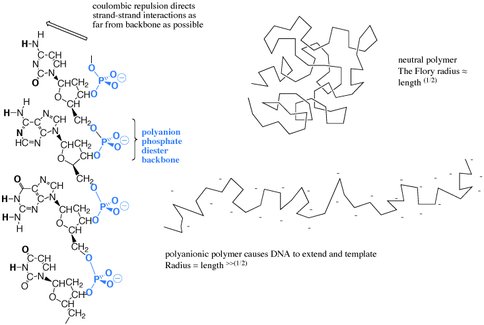2014 Annual Science Report
 NASA Jet Propulsion Laboratory - Titan
Reporting | SEP 2013 – DEC 2014
NASA Jet Propulsion Laboratory - Titan
Reporting | SEP 2013 – DEC 2014
Titan as a Prebiotic Chemical System - Benner
Project Summary
In 2007, NASA sponsored a committed of the National Academies of Science to explore whether life might exist in environments outside of the traditional habitable zone, defined as positions in a solar system where liquid surface water might be found. Alternative solvents which have analogous “habitable zones” farther away from their star include hydrocarbons, ammonia, and dinitrogen. The core question asked whether life having genetic biopolymers might exist in these solvents, which are in many cases (including methane) characterized by the need for “cold” (temperatures < 100K in the case of methane).
These “weird” solvents would require “weird” genetic molecules, “weird” metabolic processes, and “weird” bio-structures. In pursuit of this “big picture” question, we turned to Titan, which has exotic solvents both on its surface (methane-hydrocarbon) and sub-surface (perhaps super-cooled ammonia-rich water). This work sought genetic molecules that might support Darwinian evolution in both environments, including non-ionic polyether molecules in the first and biopolymers linked by exotic oxyanions (such as phosphite, arsenate, arsenite, germanate) in the second.
In the current year, we completed our studies that identified biopolymers that might work in hydrocarbon solvents. These studies have essentially ruled out biological processes in true cryosolvents. However, a series of hydrocarbons containing different numbers of carbon atoms (one, two, three, and four, for example, in methane, ethane, propane, and butane) cease to be cryosolvents as their chain lengths increase. These might be found on “warm Titans”. Further, they might exist deep in Titan’s hydrocarbon oceans, where heating from below would lead to warm hydrocarbon oceans.
These studies showed that polyethers are insufficiently soluble in hydrocarbons at very low temperatures, such as the 90-100 K found on Titan’s surface where methane is a liquid at ambient pressures. However, we did show that “warm Titans” could exploit propane (and, of course, higher hydrocarbons) as a biosolvent for certain of these “weird” alternative genetic biopolymers; propane has a huge liquid range (far larger than water). Further, we integrated this work with mineralogy-based work that allows reduced molecules to appear as precursors for less “weird” genetic biomolecules, especially through interaction with various mineral species, including borates, molybdates, and sulfates.
Project Progress
This year showed the completion of collection of experimental data related to the possibility of life on modern Titan and on “warm Titans” having hydrocarbon liquid phases:
This work exploited a “synthetic biology” strategy, where molecules believed (for theoretical reasons) to have genetic potential were synthesized in the laboratory and examined in various solvent mixtures relevant to those found on Titan. For hydrocarbon solvents, the “polyelectrolyte theory of the gene” (Fig. 1) was used as the basis for the development of genetic systems that might work outside of water. Here, we studied polyethers, which replace the repeating backbone charge, unable to support Darwinian evolution in hydrocarbons, by a repeating dipolar unit that has its negative end uniformly pointing outwards (Fig. 2). We found these to be insufficiently soluble in hydrocarbons at the 90-100 K on Titan’s surface to be plausible genetic biopolymers there. However, we showed that these were sufficiently soluble to be plausible genetic biopolymers in warmer hydrocarbon solvents, including propane as a biosolvent. The “habitable zone” for propane solvents might include planets having an orbit near that of Mars.
This work was then shepherded through the publication process. Interestingly, Cosmos magazine has picked this story up, and will run a spread on the potential of life in hydrocarbon solvents in the next few weeks.
In parallel, we joined this work to other work that studies how reduced organic molecules (including those that contain oxygen) serve as precursors for better knowngenetic biomolecules, especially via interaction with mineral species. We had the pleasure of hosting Yoshihiro Furukawa, professor at Tohoku University in the geology department. This work showed that borate, molybdate, and gypsum species were useful in controlling the reactivity of these organics, allowing them to avoid “asphaltization” that plagues much organic prebiotic proposed processes.

Publications
-
Benner, S. A., Bains, W., & Seager, S. (2013). Models and Standards of Proof in Cross-Disciplinary Science: The Case of Arsenic DNA. Astrobiology, 13(5), 510–513. doi:10.1089/ast.2012.0954
-
PROJECT INVESTIGATORS:
-
PROJECT MEMBERS:
Steven Benner
Project Investigator
McLendon Christopher
Collaborator
Myong Jung Kim
Collaborator
Jeffrey Opalko
Collaborator
-
RELATED OBJECTIVES:
Objective 1.1
Formation and evolution of habitable planets.
Objective 1.2
Indirect and direct astronomical observations of extrasolar habitable planets.
Objective 2.2
Outer Solar System exploration
Objective 3.1
Sources of prebiotic materials and catalysts
Objective 3.2
Origins and evolution of functional biomolecules
Objective 3.4
Origins of cellularity and protobiological systems
Objective 4.1
Earth's early biosphere.
Objective 5.3
Biochemical adaptation to extreme environments
Objective 6.2
Adaptation and evolution of life beyond Earth
Objective 7.1
Biosignatures to be sought in Solar System materials
Objective 7.2
Biosignatures to be sought in nearby planetary systems
